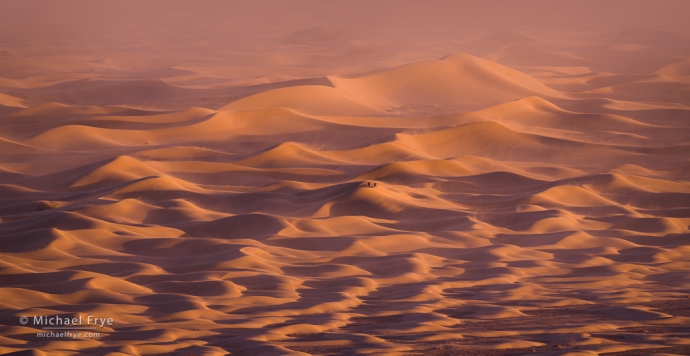
Dunes in a sandstorm, Death Valley, California. Made before our workshop from a spot overlooking the dunes. I used my longest lens here (400mm), and even then had to crop this slightly. A brief lull in the wind allowed me to use a slowish shutter speed (1/10th sec.) at 100 ISO and get a sharp photo. As you can see, some photographers did make it out to the dunes that morning. One of them is kneeling down to take a picture, which I wouldn’t recommend, as there’s a hundred times more sand blowing around at ground level than at eye level in conditions like this. 400mm, 1/10 sec. at f/11, ISO 100.
Claudia and I just got back from spending another two weeks in Death Valley. This time I was teaching a workshop for Visionary Wild with my co-instructor Jerry Dodrill.
Jerry, Claudia and I scouted together before the workshop, and hung out and explored a bit afterward. Jerry is a super nice guy, and a great photographer and teacher (you can find his website here, and Instagram feed here). We really enjoyed spending time together and teaching together, and our workshop group was wonderful, which made it all even more fun.
Prior to the workshop we experienced another big sandstorm. Jerry, Claudia, Dan (one of the workshop participants, and Jerry’s friend), and I drove out to the Mesquite Flat Dunes, but when we got there decided it was too windy to head out into the dunes. I might have tried it if I had goggles, but just standing by the cars our eyes were getting very irritated from all the blowing sand, and we could only imagine it getting much worse if we were actually in the dunes. So we decided to head up to a spot overlooking the dunes, where we could be mostly out of the dust at least, if not out of the wind.
And, of course, by the time we got to our overlook the wind had died somewhat, so maybe we could have gone out to the dunes after all. But in the end I really enjoyed this different perspective. I used long lenses to pick out patterns in the dunes below, or slightly wider telephotos to show clouds of dust blowing by above the sand:
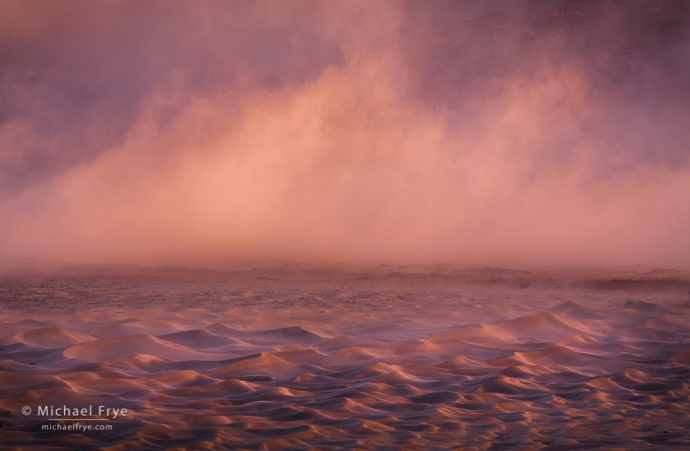
Dunes and blowing sand, sunrise, Death Valley, California. Made on the same morning as the photo above, with a cloud of sand blowing by, and the exposures timed for lulls in the wind. 206mm, 1/20 sec. at f/11, ISO 400.
It can be difficult to get sharp photos in the wind with long lenses. Even on a sturdy tripod, the wind catches the lens and causes vibrations, and the longer the lens, the more those vibrations get magnified. To get sharp photos you either have to wait for a momentary lull in the wind, or use a fast shutter speed. I’d like to have a shutter speed at least as fast as the focal length of the lens. In other words, if the focal length is 200mm, then I want a shutter speed of 1/200 sec. or faster. If the focal length is 400mm, then I’d like to get a shutter speed of at least 1/400 sec. Getting fast enough shutter speeds sometimes requires pushing up the ISO, but I’d much rather have a sharp photo with some noise than a photo that’s noise-free but fuzzy. I can deal with the noise, but I can’t fix a blurry image.
Later, during the workshop, we had mostly calm conditions, and beautiful light. But we did encounter another windstorm. The wind was accompanied by clouds in the morning, so we went to Zabriskie Point to catch dappled light with the dust blowing by in the background:
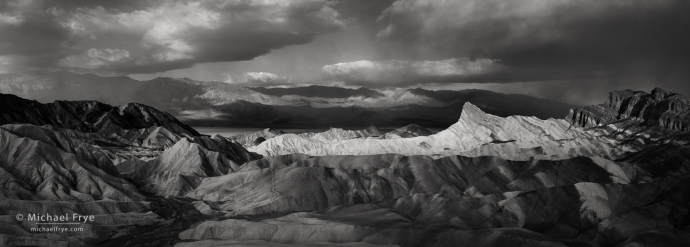
Zabriskie Point panorama, Death Valley, California. On this windy, cloudy morning we took our workshop group to Zabriskie Point to capture the dappled light with dust blowing by in the background. This panorama was stitched together from nine original frames, with the camera oriented vertically, each at 50mm, 1/160 sec. at f/11, ISO 100.
That afternoon we photographed in a sheltered canyon for awhile, then came out and caught the setting sun backlighting the sand blowing off the valley floor:
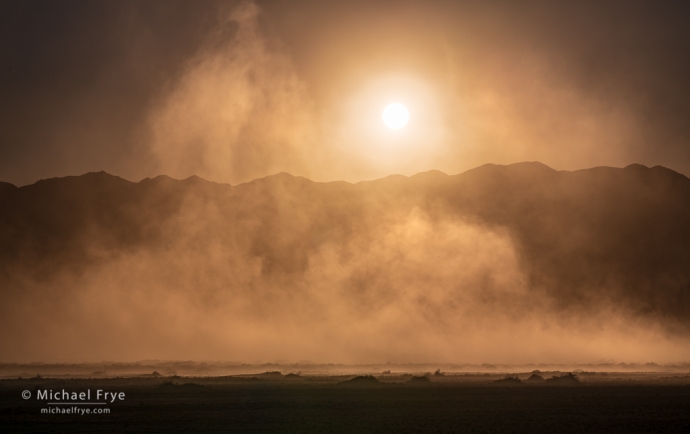
Dust storm, setting sun, Death Valley, California. During our workshop we found this beautiful scene, with backlit dust against the dark mountains. It was a challenging situation to photograph, however, with high contrast, potential for lens flare, and high winds causing vibrations with long lenses. I decided to try including the sun to give the image a visual focal point. Luckily the flare was minimal, probably because the sun was partially obscured by the dust. 133mm, three bracketed frames, two stops apart, shutter speeds of 1/500, 1/2000, and 1/8000 sec. at f/16, ISO 100, blended with Lightroom’s HDR Merge.
And the next morning we took the group out to the dunes, which had been swept free of footprints, with fresh, sharp ridges and ripples in the sand:
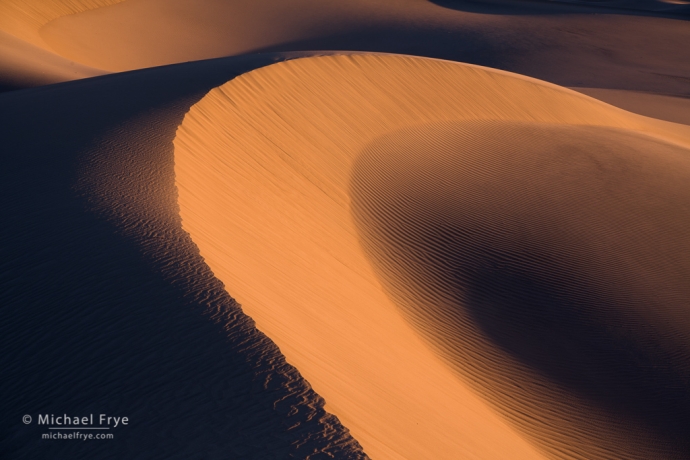
Curving dune, sunrise, Death Valley, California. The next morning we found the dunes swept clean, with sharp ridges and ripples etched by the wind. 100mm, 1/20 sec. at f/16, ISO 100.
Wind and dust can be a hazard in Death Valley. (Among other things, the power was out for about five hours on that windy day during our workshop.) But the wind can also create some wonderful opportunities for photographs. The blowing dust and sand is the closest thing to mist or fog you’re likely to see in this park, creating some beautiful atmospheric effects. And the wind refreshes the landscape.
Although the Mesquite Flat Dunes are the most accessible and most photographed dunes in Death Valley (and probably in the entire country), there are lots of other dunes in California, and in Death Valley. Before and after our workshop Claudia and I got to visit some of those other dunes, and I’ll post some photos from those places soon.
And Jerry and I will be leading another trip for Visionary Wild next month – rafting down the Grand Canyon. I’m really looking forward to that!
— Michael Frye
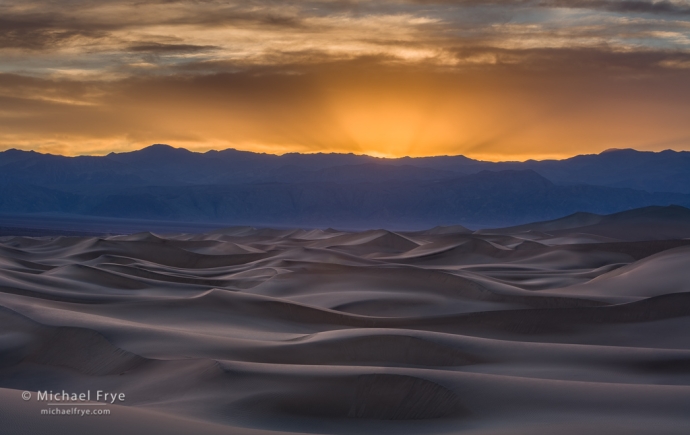
Sand dunes at sunset, Death Valley, California. We saw this beautiful sunset on the first evening of our workshop. 70mm, five bracketed frames, two stops apart, each at 1/16, ISO 100, blended with Lightroom’s HDR Merge.
Related Posts: Dust Storm; Desert Designs
Michael Frye is a professional photographer specializing in landscapes and nature. He is the author or principal photographer of The Photographer’s Guide to Yosemite, Yosemite Meditations, Yosemite Meditations for Women, Yosemite Meditations for Adventurers, and Digital Landscape Photography: In the Footsteps of Ansel Adams and the Great Masters. He has also written three eBooks: Light & Land: Landscapes in the Digital Darkroom, Exposure for Outdoor Photography, and Landscapes in Lightroom: The Essential Step-by-Step Guide. Michael has written numerous magazine articles on the art and technique of photography, and his images have been published in over thirty countries around the world. Michael has lived either in or near Yosemite National Park since 1983, currently residing just outside the park in Mariposa, California.









Wow Micheal, these are spectacular! I have experienced dust storms at Burning Man but never at Death Valley! I think you should call ‘curving dunes’, “the black hole. “ I think that is the coolest picture I’ve ever seen of the Death Valley dunes!
Thanks so much Sally! Glad you like these, and especially that dune photo.
Hi Michael:
Great shots of the dunes: I went out to DV over the president’s day weekend and went to Stovepipe wells to camp, big mistake. I think I got the last spot on Sunday! Never have I seen so many people there. Went out to the dunes at dawn on Monday and it looked like an army had marched through. The number of foot prints was really amazing! So glad that the wind storms erased the prints like an etch-a-sketch.
I have a question. Where did you go to get the telephoto shots looking down on the dunes? Did you go up mosaic canyon or grotto canyon? Just curious. On Monday night it actually snowed at about 1000 ft elevation! Very scenic.
Thanks Edward! Yeah, Death Valley has become very popular, with photographers and everyone else. The area near the main parking lot for the dunes gets tracked up quickly, but even more distant parts of the dunes get tracked up if there hasn’t been wind for awhile. On the other hand, it doesn’t take a lot of wind to clean up most of the prints. I don’t discuss precise locations unless they’re already very well known, but I’m sure you can find some spots.